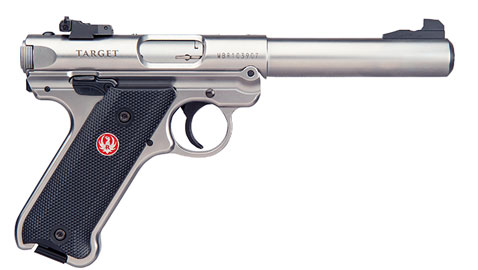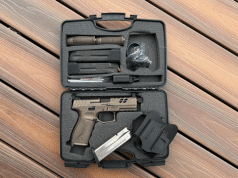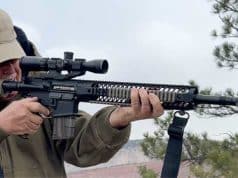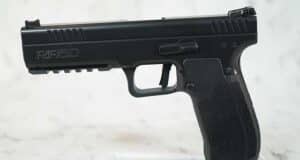
A few seasons ago on GUN STORIES WITH JOE MANTEGNA, Joe told a story that probably everybody in the industry had heard in one form or the other. The great Bill Ruger went to sleep one night and, in a dream, God revealed to him the plans for the Ruger Standard, the .22 pistol that would launch one of the greatest gun companies in the world and would quite literally “set the standard” for all .22 semi autos that would follow.
God meticulously showed Bill Ruger how to take the new Luger-like .22 apart, but, sadly, Bill Ruger woke up before God showed him how to put it together again.
And from the time of its introduction in 1949, the Ruger Standard, and later the Mark series through the current Mark III, have indeed set the standard that all other .22 semiautos aspire to. In fact, in its early days the legendary bullseye shooter and gunsmith Jim Clark Sr. won a bullseye national championship with an out-of-the-box Ruger .22. And despite its extraordinary record of success after success, the thing is still a damned bear to reassemble.
I have disassembled for cleaning and attempted reassembly of I don’t know how many Ruger .22s, and I have the scars to prove it. I would rather drive a staple into my forehead than reassemble a Ruger .22
Until now.
The clouds clear, the sun shines forth, and the Ruger Mark IV rises like a great stainless steel Phoenix, a masterpiece of a .22 that…wait for it…wait for it…disassembles with the simple push of a button.
When Brandon Trevino handed me the Mark IV Hunter at the Ruger event at FTW Ranch last weekend, he said, “Look at the back of the gun, below the bolt toggle. See that button? Push it.”
I pushed the button with my thumb, and as if by hand of the occult, the Mark IV broke apart, like popping the rear pin of an AR. I lifted the barrel up and off the frame (be still my beating heart!), then slipped the bolt out into my waiting palm.
Incredible! Push one button and you’ve got a disassembled Mark IV ready for cleaning.
“What’s the catch?” I asked. “There’s some sneaky secret to putting this puppy back together, isn’t there?”
“Nope,” said Brandon. “Even you can do it.”
And I did.
Then we gun writers, faced with buckets of OPA* (Other People’s Ammo) proceeded to shoot the living heck out of the gun. All the Mark IVs ran like tops (we were shooting Eley Force high-velocity .22s, which isn’t exactly chopped liver. Whether the guns will run with mystery metal .22s manufactured by Yetis in Umgowwastan, I neither know nor care. The new Mark IV looks like the old Mark III, mostly, but the grip frame is machined from a single piece of stainless steel (or aluminum…more about that later), as opposed to the two-piece grip frame pioneered by Bill Ruger in the late 1940s. Precision stamping and welding was state-of-the-art immediately after World War II, which why Bill Ruger went down that path.
But modern CNC machines have changed all that, and Ruger remains on the cutting edge. Almost nothing interchanges with the previous Mark series guns (The III and IV do use the same 10-round drop-free magazines). Gone are the small nubs for the safety and the bolt release, replaced with extremely serviceable — and flat, as God and John Browning intended — controls.
My good pal Ed Head has a longer evaluation here as well, but I wanted to go in a slightly different direction. As one of the three co-founders (along with Ken Jorgensen of Ruger and veteran .22 competitor Nelson Dymond) of the Ruger Rimfire Challenge, which became the NSSF Rimfire Challenge, I have shot a lot of rounds through Ruger .22 semiautos in virtually every flavor and numerous “hybrids,” built by such excellent makers as Tactical Solutions and Volquartsen. I think I shot my first Ruger Standard when I was eight years old, the year I learned how to reload .357 magnum ammunition.
I know these guns as well as I know any gun made. I have fired literally hundreds of thousands of rounds through them, stood on the firing line more times than I can remember waiting for that buzzer to go off. I have taken them apart, painstakingly reassembled them, changed pretty much every part in the gun that can be changed, given numerous custom gunsmiths ulcers with my pissiness on exactly how I wanted the little Ruger to feel.
If you recall, I went on a crusade a couple of years ago to build what I thought was the perfect NSSF Rimfire series pistol. I had been shooting Ruger 22/45s, the polymer-framed version of the Mark series that mimicked the grip angle and feel of the 1911. While the Tac-Sol upper’ed guns were crazy accurate, I wanted a little more weight. I changed over to a Mark III Target with it’s bull barrel, but that little bear was just too heavy (I said I was pissy already). I finally settled on a 6-inch Tac-Sol upper on the Mark III frame that had the trigger overhauled by Majestic Arms on Statin Island. One of the other modifications, BTW, was adding a “Speed Strip” kit to make the gun easier to disassemble…and reassemble.
It was the single best Mark series pistol I’d ever fired… until last weekend.
Ruger rolled out three of the new Mark IVs, a stainless steel Target with the 5.5 inch bull barrel, a blue Target with an aluminum frame (which comes in at 35.6 ounces versus the stainless 42.8 ounces) and the stainless Hunter with its 6.88-inch fluted barrel and 44 ounce weight. I kept coming back to the stainless Hunter.
Even though I wasn’t crazy about the rear V-notch sights (an easy fix), the fiber optic front was excellent. The trigger was far more than adequate…call it about 4 pounds. The gun just felt right. Occasionally, rarely, a firearm becomes more than the sum of its parts. I would say the Mark IV Hunter is the single best Ruger Mark series gun I have ever shot, including my own customs.
It is Bill Ruger’s greatest dream.





Will they make it with a threaded barrel in the future?